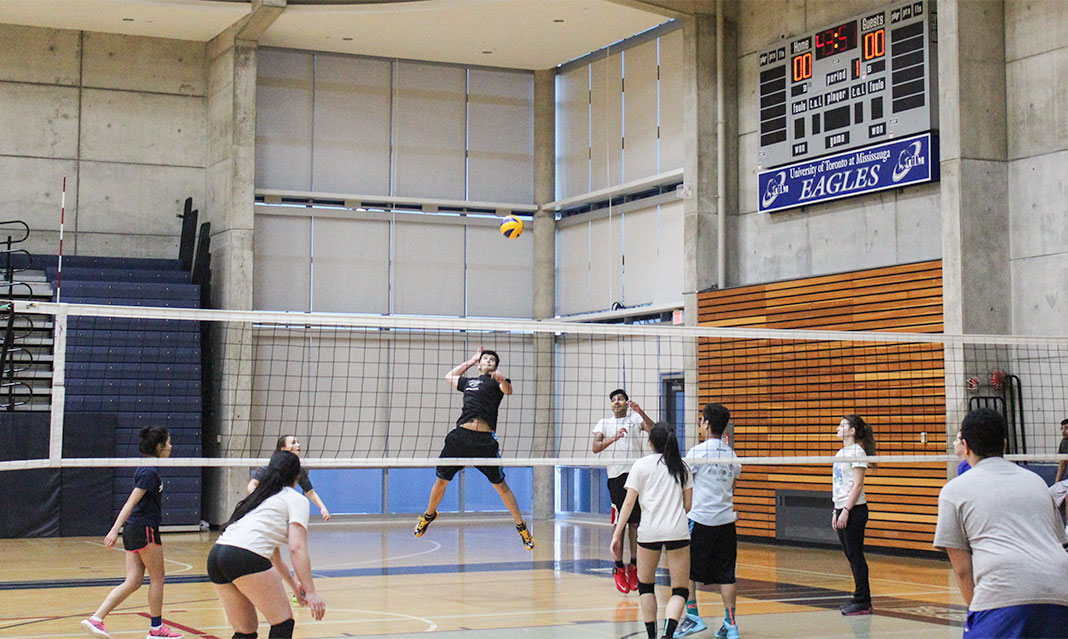Last Thursday, the UTM Campus Rec Coed Intramural volleyball teams bumped, set, and spiked their way closer to earning a spot in the division playoffs. The intramural season is currently underway, and players with skillsets ranging from beginners to veterans come out to hit the courts. But what motivates players to participate in co-ed winter volleyball intramurals?
The answer was unanimous—a love for the game and an enthusiasm to build friendships.
Bryan Calucag, league commissioner for campus rec volleyball and fifth-year double major in psychology and anthropology, explains that during the regular season, each team plays two sets. The gym is divided into three courts, allowing six teams to play in the first hour from 5-6 p.m. on Thursday nights and another six teams to play for the second hour. If a team wins two sets, the win translates to six points, and if they win no sets, then they receive two points. At the end of the season, campus rec awards the winning team t-shirts, and the players get a photo with their trophy.
For Calucag, volleyball has always been a significant part of his life. Currently, he works for the Ontario Volleyball Association, where he is an official for beach volleyball and refs Ontario league games. Calucag brings his passion for the sport and his competitive spirit to the UTM courts as well.
“[The OVA] is serious competition, and I bring that into here. What I’ve done this year is I’ve contacted both of the school teams, men’s and women’s, to get as many players out to make their own teams and increase competition in the league,” Calucag explains.
Teammates and division two champions for the past two seasons, Tajea Meredith and Tara Varela, agree that the best part about co-ed volleyball is the connection that playing on a team generates for its members.
“I love volleyball, and it’s fun just to play with the people I’ve grown to know a lot better,” says second-year forensic anthropology student, Meredith. “It’s good competition. It really pushes you to work hard, but it’s not professional volleyball, so the pressures of being perfect all the time isn’t there.”
For Varela, a second-year double major in criminology and PWC, since winter volleyball is played indoors, it’s a lot different than beach volleyball.
“It’s more fun to play with six people. What motivates us is that it’s fun to play with your friends and to hit a really good ball,” says Varela.
Both women have previous experience playing volleyball with their high school or rep teams. They explain that their team, Spikers, typically practices whenever everyone’s schedules align and before a big game.
Luckily, Varela and Meredith don’t allow their athletics to interfere with their academics.

“For me, I think I don’t even have to balance it because it’s a part of your schedule. It’s a good stress reliever, it’s good for workouts, and it’s good to spend time with your friends. It’s not like you make time for this, it’s just part of your day,” Varela says.
Other players recommend having good time management skills in order to balance commitments. Omran Sharifi, a fourth-year majoring in economics and CCIT, advises his fellow athletes to utilize their off-days to finish school work and to make sure they allocate time to train as well. Sharifi plays on both an intramural team and the UTM men’s D-league volleyball team.
His motivation stems from his environment and his teammates. He believes that the best part about playing is the competition among players.
“We all try to be on different teams and try to be as competitive as possible. Trash-talking is also a little bit of fun too,” Sharifi laughs. “I bring a bunch of my friends who don’t play volleyball. They’re amateurs, but they’re getting better at it every day.”
Joel Mcleod, a first-year in social science, shares the same mindset as his colleagues. His love for the game motivated him to join intramurals, and he credits social media for helping bring his team together.
“It’s a lot of hard work. You just have to have time scheduled for [academics and athletics]. Focus on both elements, focus on your health, focus on the enjoyment of playing the game, and focus on the part that’s going to catapult you into society,” Mcleod says.
Teams are categorized into divisions to ensure players face off against people with a similar skillset. Although players range in ability, the league places the top six teams into division one and the next six into division two.
“Intramural co-ed volleyball changed my experience at UTM,” says Varela. “You just create so many connections.”



